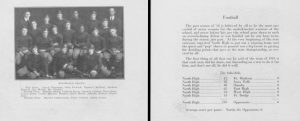
In 1918 – between two rounds of school closings during a flu pandemic – the North High School football team won a state championship. (Click image to enlarge this page from the North Oracle yearbook.)
The photo above is of a group of students at Oak Park school, taken in 1918. A handwritten note reads “Kindergarten knitters during the war.” While Americans of all ages rallied around the American doughboys fighting in the trenches of France, a different war of sorts was underway that year on the homefront.
The current COVID-19 pandemic is an unprecedented experience for virtually everyone who’s alive today. But Des Moines Public Schools is old enough to have some basis for comparison to a similar situation, the great flu pandemic of 1918.
On October 10 of that year, Mayor Fairweather (yes, his real name) issued a proclamation based upon recommendations of the local board of health that closed most public places, including schools.
The global backdrop for that pandemic was World War I, a key factor in the spread of influenza here. Camp Dodge, just north of Des Moines, was crowded with soldiers in training despite that it was still under construction. Laborers mingled with sick troops as the base became the epicenter of cases and carried the illness home with them from work.
On the same day of Mayor Fairweather’s proclamation, the Des Moines Register ran a story right next to it about a local doctor whose theory it was that the flu wasn’t spread by “germs” but “atmospheric conditions.” He explained the outbreak at Camp Dodge as the result of troops in vigorous physical training cooling too rapidly. Who you listen to in the midst of public health crises is no less critical in the 21st century than it was in the 20th.
Perhaps a key point of comparison between then and now to consider as the appropriate length of the schools closure is debated is that the one a century ago was relaxed on October 28, less than three weeks after it was first imposed. But the reopening proved premature when another outbreak flared.
There weren’t the diversions and technical alternatives then that are available to us now and officials weighed factors like the importance of community morale and amusement as well as education in their decision-making. Half-measures were tried like limiting public venues to half-capacity and requiring patrons to wear masks. But folks soon complained they felt like they were attending masquerade parties when they went to movies and dance halls, so masks became optional.
The school board planned to reduce holiday breaks from school to try and make up for some of the lost time, also factoring in the need to dismiss male students from classes in time for the spring planting season.
Schools remained open long enough for North High to defeat Fort Dodge 14-0 on Thanksgiving Day in a game played in mud and snow and win the state championship in football. The Des Moines Register included that account in a newsletter insert to its December 8 editions that readers were encouraged to clip and mail to Iowa boys on the WWI frontlines in France.
Ultimately, the schools re-closed shortly after Thanksgiving and stayed shuttered until December 30.
Other points of interest include that spitting on the sidewalk was grounds for arrest in 1918 and citizens were encouraged to donate lemons to the troops at Camp Dodge as a therapeutic measure to prevent and treat the flu afflicting their ranks.
Some things to think about as we continue trying to squeeze lemonade from the COVID-19 lemon.
(This retrospective was compiled by our staff writer Mike Wellman from a review of local Des Moines news accounts archived by newspapers.com and “The American Influenza Epidemic of 1918-19: A Digital Encyclopedia” produced by the University of Michigan Center for the History of Medicine.)





